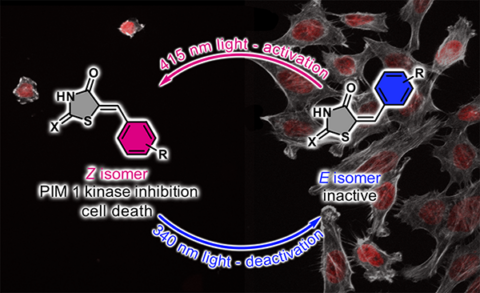Switching molecules on & off by light to control cellular dynamics
Diseases are usually restricted to a certain organ or tissue in the human body. However, medications are typically not only administered to the site of disease but to the entire body. This can damage healthy tissue and cause unwanted side effects. To overcome this problem photopharmacology aims to develop light-responsive molecules whose activity can be restricted to a local area by focused light irradiation.
In a collaborative project the research groups of Prof. Henry Dube (Department of Chemistry and Pharmacy) and Prof. Esther Zanin (Department of Biology) established a new class of light responsive molecules, based on (oxo-)rhodanine, and demonstrated that their activity can be controlled with light in cancer cells. Laura Köttner, a PhD student in the Dube group synthesized and characterized a number of known and novel (oxo-)rhodanine-based molecules. She showed that these chromophores can undergo reversible changes in their structure and properties in response to light and are therefore classified as molecular photoswitches. Photoswitching between the two states (called Z and E isomers) can be induced by UV and blue light irradiation and causes among other things a change in color of the molecules.
By just exchanging one atom in the molecule’s core or changing substituent groups the photophysical and photochemical properties of these photoswitches can be easily modulated for different applications. The function and efficiency of the developed molecules was then tested in human cancer cells by Friederike Wolff, a PhD student in the Zanin group. Incubation of cancer cells with the active Z isomer inhibits an important signaling protein called PIM-1 kinase and thereby induces cell death. Friederike Wolff then incubated cancer cells with the E isomer and interestingly all cells survived showing that the E isomer is inactive.
However, incubating cells with the E isomer and applying 10 seconds blue light irradiation of 415 nm, triggered the photoswitching from the E to the Z-isomer, inhibited PIM-1 kinase, and induced death of the cancer cells. Inversely, incubating cells with the active Z isomer and exposing them to 10 seconds of UV light irradiation caused photoswitching from the Z (active) to the E-isomer (inactive) and many cells survived.
Together this establishes rhodanine-based chromophores as light controllable photoswitches to manipulate cellular signaling and programmed cell death by external irradiation.
In general, rhodanine-based chromophores are the basis of wide variety of functional molecules that are applied in different areas ranging from anti-inflammatory treatment, to ion sensing, to solar-cells. So, this work opens a tremendous new window of opportunity for applying rhodanines also as light-switchable molecules in a broad range of different applications in the future.
The study was published:
Rhodanine-Based Chromophores: Fast Access to Capable Photoswitches and Application in Light-Induced Apoptosis, Laura Köttner, Friederike Wolff, Peter Mayer, Esther Zanin*, and Henry Dube*, J. Am. Chem. Soc. 2024.
Further information:
Prof. Dr. Henry Dube
Department of Chemistry and Pharmacy
Chair of Organic Chemistry I
- E-Mail: dube@fau.de
- Website:https://www.chemistry.nat.fau.eu/dube-group
Prof. Dr. Esther Zanin
Department of Biology
(Prof. Dr. Zanin)
- E-Mail: zanin@fau.de
- Website: https://www.zelldynamik.nat.fau.de/

